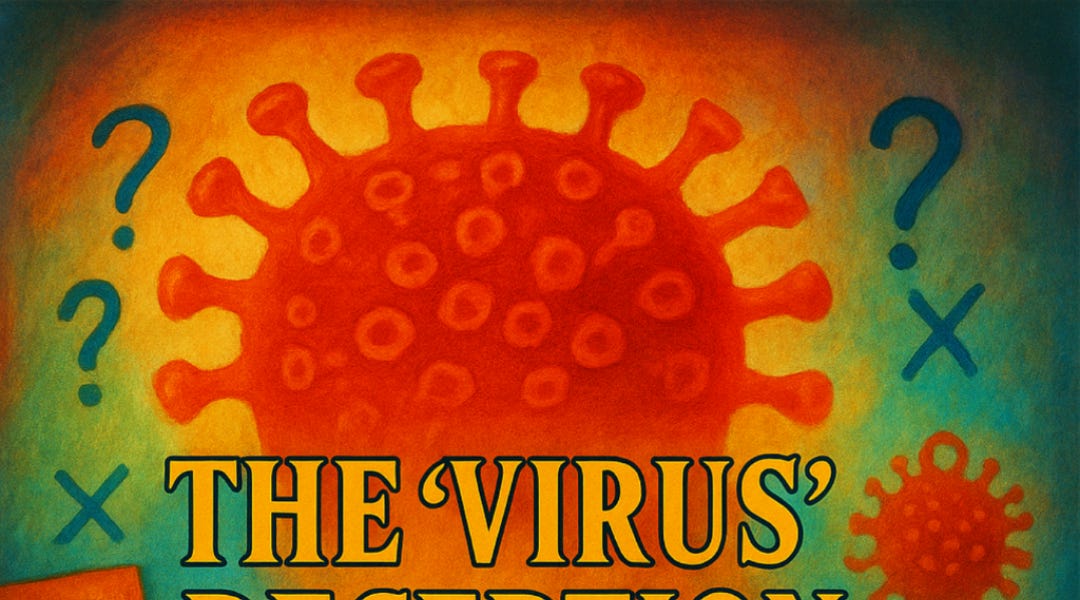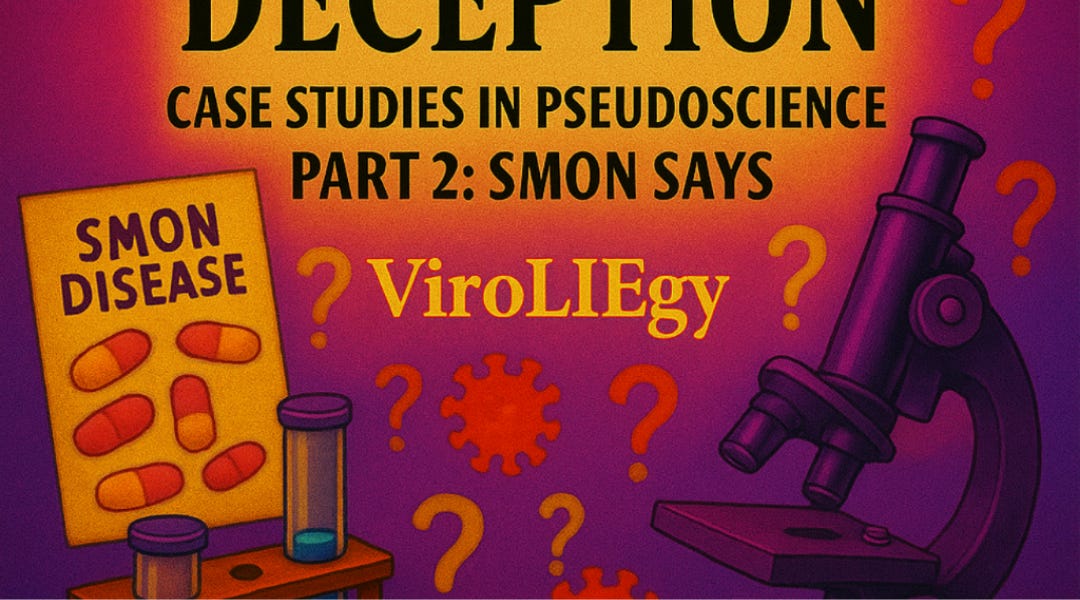You are using an out of date browser. It may not display this or other websites correctly.
You should upgrade or use an alternative browser.
You should upgrade or use an alternative browser.
APP - Do biological viruses actually exist?
- Thread starter Scott
- Start date
Viruses are not bacteria. It is circular reasoning to demand the viruses act like bacteria and then claim that viruses don't exist because they don't act like bacteria. You deny the common definition of isolation when it comes to viruses and pretend that isolation has never occurred because of that denial of the common definition.I just quoted part of the statement from the opening post of this thread, a statement published back in 2022. If you can find a single example where the commonly accepted definition of isolation has actually been used in virology, by all means present it.
You deny relying on his work to make the case the virology is pseudoscientific and then rely on his work to make the case that virology is pseudoscientific. Your attempts at obfuscation are this point are so lacking in logic that you are proving yourself to be ridiculous. Pasteur being wrong doesn't show that viruses exist or don't exist. Pasteur being wrong doesn't show that anyone else is wrong about viruses. Your use of Pasteur is just a logical fallacy that you hope no one will notice. Relying on errors in Pasteur's work is simply a logical fallacy as you try to argue wrong in one thing is wrong in all.I've never relied solely on Pasteur's work to make the case that virology is pseudoscientific. He's just one of the first examples of authoritative men using pseudoscientific means to push theories that ultimately played a large role in current mainstream beliefs regarding biological viruses.
I realize that because you refuse to actually look at any evidence but simply keep going to the same 3 sources over and over and over and over and over and over and over and over and over and over and over and over and over and over and over and over and over and over and over and over and over and over and over and over ....I've seen no such evidence.
I presented you with 20 scientific articles and you have failed to address even one of them. Instead you simply repeat your same lame sources that are riddled with logical fallacies.If what you say is true, you should be able to provide at least one study that actually shows that solid evidence that an alleged virus is spread by infection. I've already provided links to articles that show the fraudulent nature of virology, but once more:

The “Virus” Deception: Case Studies in Pseudoscience — Part 1: The “Lipovirus”
How a speculative agent with no direct evidence was framed as a causative "virus."mikestone.substack.com

The “Virus” Deception: Case Studies in Pseudoscience — Part 2: SMON Says
"Act like a virus!"mikestone.substack.com
Once again. We are here where you simply refuse to look at any evidence and since you haven't looked at any evidence you can claim you haven't found any evidence. Let me know when you are willing to address the 20 scientific papers I posted showing that viruses have been isolated.For starters, "viruses don't exist" isn't an argument, it's a statement. -We- are engaged in an argument, wherein you believe that biological viruses exist and I don't. But I have never stated that I have -proof- that biological viruses don't exist, just as I have never stated that I have proof that unicorns don't exist. The issue is whether there is any solid -evidence- that biological viruses exist. I have yet to find any.
Let's put this into perspective. You keep quoting Mike Stone but I have seen no evidence that Mike Stone exists. Since there is no evidence that Mike Stone exists and certainly no evidence of Mike Stone being isolated in the way the common definition of isolation is used by you your statement is based on fantasy and not anything that actually exists.
So you decided to make multiple posts this morning about how you have seen no evidence while admitting that you refused to look at and address evidence you were shown. This is clear evidence that you do not look at any evidence of viruses. You flat out refuse to look at or address any evidence that they exist.I didn't ignore that post, I just hadn't gotten to it when you wrote your post. My response to your post is here:
Let me know when Mike Stone, Dr Bailey or you have refuted any of the following -Alright, show me this evidence then.Unsubstantiated assertion on your part. There is a lot of solid evidence that a lot of microbes fit the definition of biological viruses. There is a lot of evidence including aver a thousand years of circumstantial evidence that viruses exist.
Then I can get to the next 20 -
Structure and Organization of Virus Genomes - PMC
This chapter provides an in depth study on the structure, composition, and organization of viral genomes, their classification into double stranded and single stranded DNA viruses, positive and negative stranded RNA viruses with and their genome ...pmc.ncbi.nlm.nih.gov
Once again, I'd like to point out that no one has said that there is proof that biological viruses don't exist. What the...
And yes, I know you responded to it in post #209. Barring my leaving this thread, I should get to it in time.
Bottom line. You say you will get to the evidence in time but until then you will simply tell us over and over and over and over and over and over and over and over and over and over and over and over and over and over and over and over that you have not seen any evidence (because you refuse to actually look at any evidence.)
And there it is again. The post after you say you haven't yet looked at the 20 papers I presented to you you claim you haven't seen any evidence.No clue where you got that idea. It's actually the reverse- I have yet to find a study that provides solid evidence that biological viruses are real. There are many badly done studies. As I've mentioned previously, Mike Stone has written articles getting into them. 2 can be seen here:

The “Virus” Deception: Case Studies in Pseudoscience — Part 1: The “Lipovirus”
How a speculative agent with no direct evidence was framed as a causative "virus."mikestone.substack.com

The “Virus” Deception: Case Studies in Pseudoscience — Part 2: SMON Says
"Act like a virus!"mikestone.substack.com
You are making it quite clear that the reason you haven't seen any evidence is because you refuse to look at any evidence.
Scott: - As to your papers, I'm not going to read any of them at this time,
Scott: - I have yet to find a study that provides solid evidence that biological viruses are real.
You will never find a study if you never bother to look at anything. The problem isn't that there is no evidence. The problem as you yourself admit is that you simply refuse to look at any evidence.
Last edited:
Once again. You are arguing from your ignorance. There are 3 ways currently to isolate viruses. You would know that if you actually read any evidence presented to you.Again, you don't understand. The method developed by Enders to "isolate" alleged biological viruses is the same one used today. This is why it's so important to understand how his method was pseudoscientific, as it firmly establishes that virology as a whole is pseudoscientific.
Scott: - As to your papers, I'm not going to read any of them at this time,
Scott: - I have yet to find a study that provides solid evidence that biological viruses are real.
I presented multiple papers showing you those 3 different ways to isolate viruses and how they are used. Enders never used DNA or RNA sequencing for viruses. Once again, you are using the same false logic in claiming Enders (like Pasteur) made mistakes so that means 75 years of science since Enders can all be ignored.
Again, microscopic particles alleged to be biological viruses have never been isolated by the common definition of the term. The "Settling the Virus Debate" statement I quote and link to in the opening post points this out.
Scott: - As to your papers, I'm not going to read any of them at this time,
Scott: - I have yet to find a study that provides solid evidence that biological viruses are real.
I presented you with 20 papers that showed viruses being isolated. You didn't read a single one of them or address what they showed. The problem isn't that there is no evidence. The problem as you yourself admit is that you simply refuse to look at any evidence.
ZenMode
Well-known member
What do you think had to happen for the entirety of the scientific/medical world (public and private, on every continent) to get together and manufacture the lie of biological viruses?I've found that the evidence supporting the existence of biological viruses to be a house of cards. As to why I came to that conclusion, I suggest you take a good look at the opening post of this thread.
ZenMode
Well-known member
What do you think had to happen for the entirety of the scientific/medical world (public and private, on every continent) to get together and manufacture the lie of biological viruses?Some people -still- believe that the earth is flat -despite- the fact that the scientific method has been around since at least the 17th century, according to Wikipedia. There is solid scientifc evidence that bacteria exist, but this has never been true for biological viruses. Mike Stone recently wrote a good article on virology's false induction into the scientific field back in the 50s recently. Quoting from the introduction of said article below:
**
In the 1950s, virology began to emerge as a distinct discipline, separating itself from bacteriology. For the first time, it was (falsely) recognized as a legitimate scientific field. This shift was largely due to the introduction of the cell culture technique by John Franklin Enders in 1954. This method, still used by virologists today, asserts “viral” presence based on lab-created, artificial effects observed in cultures of human and animal cells.
Around the same time, electron microscopy became more widely available, allowing researchers to peer into unpurified culture soup and label random particles from the destruction of these cells as “viruses.” After decades of vagueness, in 1957, French microbiologist André Lwoff offered a consensus definition for the invisible entities virologists claimed to be studying. Journals were launched to publish the work of these newly anointed experts. It was a decade of enormous “progress” for the pseudoscientific field.
Emboldened by these tools and techniques, “virus” hunters began “discovering” new “viruses” with remarkable ease—despite never having the actual agents in hand to study. But in their rush to interpret indirect, nonspecific, and artificial lab effects as proof of “viral” entities, virologists set the field on a path of misinterpretation, speculation, and pseudoscience.
This pattern soon played out across a range of illnesses in need of a theoretical “pathogen.” One prominent example was hepatitis. According to the editorial Candidate Viruses in Hepatitis, researchers had previously relied on serologic “antibody” testing and human volunteer inoculation in an attempt to prove a “viral” cause for the disease, but the invisible culprit remained elusive. Results that appeared promising for one group were often not reproducible by others—a direct violation of a foundational principle of the scientific method. Yet despite lacking a purified “virus” and failing to replicate findings, researchers still labeled these mysterious agents as “candidate viruses,” signaling nothing more than an unproven suspicion of causation.
The first “candidate virus” for hepatitis was “discovered” by Werber Henle in 1954 using Maitland-type chick embryo tissue cultures. However, his attempts to demonstrate an “infectious virus” failed: the inoculated volunteers showed no serologic response, and no “immunity” could be observed upon re-challenge.
Over the next decade, numerous labs claimed to isolate “candidate viruses” from hepatitis patients using a variety of human and animal tissue cultures. These included:
Despite these numerous claims, no consistent or definitive evidence ever established a direct causal link between any of these agents and hepatitis. Researchers experimented with various tissue and cell cultures, hoping to find a formula that would recreate the disease and produce the expected indirect signs of “infection.” When a particular result appeared to match their expectations, they rushed to assume a “viral” cause. They would name a supposed “virus” and then treat it as if it had been proven to cause the artificial, lab-created effects they had generated. In doing so, they engaged in fallacious reasoning—such as affirming the consequent and post hoc fallacies—deceiving themselves into believing that the invisible culprit was in hand.
- Rightsel and Boggs: Claimed hepatitis-like illness was caused by injection of “infected” culture fluid.
- Davis: “Isolated” the so-called San Carlos agents (“adenoviruses”) from children’s stool, but no direct link to hepatitis was found.
- Chang: Reported a “lipovirus” from hepatitis patients’ blood, but could not classify it or establish any association.
- O’Malley: “Isolated” the “A-1 virus” from serum; results were inconsistent, and serologic relationships were unclear.
- Bolin et al.: Claimed “isolation” of a “virus” from volunteers given a known serum hepatitis sample.
- Hillis: Observed cell damage from hepatitis patient serum, but the effect was lost in serial passage.
- Hsiung et al.: Found a “myxovirus” (DA “virus”) in a fatal case, but refrained from claiming causation.
- Schneider et al.: Detected agents in both chronic and acute cases using canine lung tissue.
- McKees: Claimed to “isolate viruses” on monkey kidney tissue from hepatitis patients, reportedly transmissible to suckling mice.
Fortunately, some researchers were honest enough to acknowledge when the evidence failed to support early assumptions of a “viral” cause. In many cases, the indirect findings not only fell short of being sufficient—they ultimately pointed away from the “viral” hypothesis altogether. One notable example comes from the work of Dr. Robert Shihman Chang, a pioneer in cell culture. He was among the first to establish immortalized lymphoid cell lines using the “Epstein-Barr Virus,” focusing primarily on developing cell lines that could support “viral” growth for in vitro study. During his investigations into hepatitis, which led to the emergence of the so-called “lipovirus” in 1960, he inadvertently demonstrated how reliance on indirect evidence—such as CPE, “antibody” tests, and electron microscopy—paired with fallacious reasoning can lead researchers to mistakenly believe they’ve discovered a new “virus,” only to later realize the trail of pseudoscientific breadcrumbs led nowhere. This is the story of how a virologist was both misled by assumptions and deceived by the very methods believed to prove a “viral” cause.
**
Full article:

The “Virus” Deception: Case Studies in Pseudoscience — Part 1: The “Lipovirus”
How a speculative agent with no direct evidence was framed as a causative "virus."mikestone.substack.com
I provided 20 scientific papers. You have not addressed one of them.I could say the same thing of you with just as little evidence. Insulting others is -so- easy. Providing evidence for one's own positions is another matter entirely.
I've gone to the very start of modern virology, Franklin Enders. All papers on virology today are based on the unsubstantiated assertions that he made. There's no point in reading papers when they all rely on the same pseudoscientific assumptions. I've quoted Mike Stone on Enders before, but perhaps you missed it or have forgotten so once more:
**
In the 1950s, virology began to emerge as a distinct discipline, separating itself from bacteriology. For the first time, it was (falsely) recognized as a legitimate scientific field. This shift was largely due to the introduction of the cell culture technique by John Franklin Enders in 1954. This method, still used by virologists today, asserts “viral” presence based on lab-created, artificial effects observed in cultures of human and animal cells.
Around the same time, electron microscopy became more widely available, allowing researchers to peer into unpurified culture soup and label random particles from the destruction of these cells as “viruses.” After decades of vagueness, in 1957, French microbiologist André Lwoff offered a consensus definition for the invisible entities virologists claimed to be studying. Journals were launched to publish the work of these newly anointed experts. It was a decade of enormous “progress” for the pseudoscientific field.
Emboldened by these tools and techniques, “virus” hunters began “discovering” new “viruses” with remarkable ease—despite never having the actual agents in hand to study. But in their rush to interpret indirect, nonspecific, and artificial lab effects as proof of “viral” entities, virologists set the field on a path of misinterpretation, speculation, and pseudoscience.
**
Full article:

The “Virus” Deception: Case Studies in Pseudoscience — Part 1: The “Lipovirus”
How a speculative agent with no direct evidence was framed as a causative "virus."
Oh.. look, you provided no evidence to support your claims.Absolute balderdash, but you're welcome to try to prove that his alternative explanations have been falsified if you like.The funny thing is all of his alternative explanations have been falsified so it proves him wrong.
It's you who've made a claim that remains unsupported here. As I said, you're welcome to try to prove that all of Mike Stone's "alternative explanations have been falsified". Somehow, I don't think you'll do it.
I think it's safe to say you are not aware of what science is.I think it's safe to say that the doctors and other researchers who no longer believe in virology would argue that viroligy is as scientific as scientology. Quoting from the statement that I quoted and linked to in the opening post of this thread:
**
After a century of experimentation and studies, as well as untold billions of dollars spent toward this “war against viruses”, we must ask whether it’s time to reconsider this theory. For several decades, many doctors and scientists have been putting forth the case that this commonly-accepted understanding of viruses is based on fundamental misconceptions. Fundamentally, rather than seeing “viruses” as independent, exogenous, pathogenic entities, these doctors and scientists have suggested they are simply the ordinary and inevitable breakdown particles of stressed and/or dead and dying tissues. They are therefore not pathogens, they are not harmful to other living beings, and no scientific or rational reasons exist to take measures to protect oneself or others against them. The misconceptions about “viruses” appears to largely derive from the nature of the experiments that are used as evidence to argue that such particles exist and act in the above pathological manner. In essence, the publications in virology are largely of a descriptive nature, rather than controlled and falsifiable hypothesis-driven experiments that are the heart of the scientific method.
Perhaps the primary evidence that the pathogenic viral theory is problematic is that no published scientific paper has ever shown that particles fulfilling the definition of viruses have been directly isolated and purified from any tissues or bodily fluids of any sick human or animal. Using the commonly accepted definition of “isolation”, which is the separation of one thing from all other things, there is general agreement that this has never been done in the history of virology. Particles that have been successfully isolated through purification have not been shown to be replication-competent, infectious and disease-causing, hence they cannot be said to be viruses. Additionally, the proffered “evidence” of viruses through “genomes" and animal experiments derives from methodologies with insufficient controls.
**
Full statement:

The “Settling The Virus Debate” Statement
drsambailey.com
You're so focused on me that you fail to recognize that I'm literally quoting the work of experienced doctors and other researchers. Mike Stone has written long essays on the evidence that virology isn't scientific, as I've already pointed out to you. For those in the audience who may not yet have seen his excellent work, here are 2 that I believe are quite good:

The “Virus” Deception: Case Studies in Pseudoscience — Part 1: The “Lipovirus”
How a speculative agent with no direct evidence was framed as a causative "virus."

The “Virus” Deception: Case Studies in Pseudoscience — Part 2: SMON Says
"Act like a virus!"
Since you haven't read the papers, how can you know what is in them? This is another example of how you refuse to look at evidence.I've gone to the very start of modern virology, Franklin Enders. All papers on virology today are based on the unsubstantiated assertions that he made. There's no point in reading papers when they all rely on the same pseudoscientific assumptions. I've quoted Mike Stone on Enders before, but perhaps you missed it or have forgotten so once more:
What is the point of having a discussion with someone that claims they have seen no evidence but then refuse to look at any evidence presented to them? I presented you with 20 papers as evidence. You refuse to read any of them. You refuse to address any of the evidence. You simply repeat ad nauseam that you haven't seen the evidence you refuse to look at.
It's impossible to prove something to you when you simply refuse to even look at any evidence that shows Mike Stone's arguments are nothing but logical fallacies. His circular arguments and arguments from ignorance don't show anything other than he like you refuses to address the actual evidence that exists.It's you who've made a claim that remains unsupported here. As I said, you're welcome to try to prove that all of Mike Stone's "alternative explanations have been falsified". Somehow, I don't think you'll do it.
You are not quoting the work of experienced doctors or researchers. You are quoting the work of charlatans that ignore the actual science and present logical fallacies.You're so focused on me that you fail to recognize that I'm literally quoting the work of experienced doctors and other researchers. Mike Stone has written long essays on the evidence that virology isn't scientific, as I've already pointed out to you. For those in the audience who may not yet have seen his excellent work, here are 2 that I believe are quite good:

The “Virus” Deception: Case Studies in Pseudoscience — Part 1: The “Lipovirus”
How a speculative agent with no direct evidence was framed as a causative "virus."mikestone.substack.com

The “Virus” Deception: Case Studies in Pseudoscience — Part 2: SMON Says
"Act like a virus!"mikestone.substack.com
Can you tell us how cell culture technique violates the isolation system that you call common that relies on cell culture techniques? Mike Stone says the virus was grown in a culture. Don't you think the common isolation system is culture growth? Or are you now denying that is the common way to isolate?
But let's look at Mike Stone's arguments. He decries the method used in 1954 for Hepatitis isolation and for the next decade.
He then ignores 60 years of science since then.
Here are 10 science articles not addressed by Mike Stone. I look forward to your reading them and addressing the isolation of hepatitis virus since 2000.
An improved method for the isolation of hepatitis B virus DNA from human serum - PMC
Studies show that hepatitis B virus (HBV) DNA isolation methods vary in their efficiency to extract DNA from serum samples. The purpose of the present study was to develop an improved method for isolation of HBV DNA and compare it with commonly used ...
Hepatitis A Virus: Essential Knowledge and a Novel Identify-Isolate-Inform Tool for Frontline Healthcare Providers - PMC
Infection with hepatitis A virus (HAV) causes a highly contagious illness that can lead to serious morbidity and occasional mortality. Although the overall incidence of HAV has been declining since the introduction of the HAV vaccine, there have ...

Isolation and propagation of hepatitis A virus in hepatoma cell cultures - PubMed
Hepatitis A virus (HAV) was isolated directly from human faeces in PLC/PRF/5 cells. In the first passage cell-bound and supernatant viruses were found by immune electron microscopy and by enzymeimmunoassay. Serial passaging of HAV in PLC/PRF/5 cells resulted in its adaptation to the cell line...

Isolation of Hepatitis E Virus From Breast Milk During Acute Infection - PubMed
Isolation of Hepatitis E Virus From Breast Milk During Acute Infection
Isolation as a strategy for controlling the transmission of hepatitis C virus (HCV) infection in haemodialysis units - PMC
The hepatitis C virus (HCV) infection affects about 2% of the world's population and can cause chronic liver infection and persistent long‐term sequelae such as cirrhosis and liver cancer. The prevalence of HCV infection among people on ...

A miRNA-responsive cell-free translation system facilitates isolation of hepatitis C virus miRNP complexes - PubMed
Micro(mi)RNAs are 21- to 23-nt RNAs that regulate multiple biological processes. In association with Argonaute (Ago) proteins and other factors that form the RNA-induced silencing complex (RISC), miRNAs typically bind mRNA 3' untranslated regions (UTRs) and repress protein production through...

A miRNA-responsive cell-free translation system facilitates isolation of hepatitis C virus miRNP complexes - PubMed
Micro(mi)RNAs are 21- to 23-nt RNAs that regulate multiple biological processes. In association with Argonaute (Ago) proteins and other factors that form the RNA-induced silencing complex (RISC), miRNAs typically bind mRNA 3' untranslated regions (UTRs) and repress protein production through...
Cell Culture Isolation and Whole Genome Characterization of Hepatitis E Virus Strains from Wild Boars in Germany - PMC
Infection with hepatitis E virus (HEV) can cause acute and chronic hepatitis in humans. The HEV genotype 3 can be zoonotically transmitted from animals to humans, with wild boars representing an important reservoir species. Cell culture isolation of ...

A miRNA-responsive cell-free translation system facilitates isolation of hepatitis C virus miRNP complexes - PubMed
Micro(mi)RNAs are 21- to 23-nt RNAs that regulate multiple biological processes. In association with Argonaute (Ago) proteins and other factors that form the RNA-induced silencing complex (RISC), miRNAs typically bind mRNA 3' untranslated regions (UTRs) and repress protein production through...
Isolation, identification and genome analysis of an avian hepatitis E virus from white-feathered broilers in China - PMC
Avian hepatitis E virus (HEV) is the major causative pathogen of the big liver and spleen disease, hepatitis-splenomegaly syndrome, and hepatic rupture hemorrhage syndrome. Until now, there are 6 different avian HEV genotypes that infect chickens ...
Dr Bailey's argument is that because viruses don't act exactly like bacteria then they don't exist.
First of all, from what I've read, Dr. Tom Cowan wrote most if not all of the "Settling the Virus Debate" statement. The Bailey doctors were 2 of the signatories of said statement. Second of all, you're clearly mistaken in your claim above, even assuming you're referring to the 2 page "Settling the Virus Debate" statement. For those who'd like to see the statement in full, I linked to it in the opening post of this thread. As to the Bailey doctors, Dr. Mark Bailey has written a very comprehensive treatise on virology that is a lot more in depth than the "Settling the Virus Debate" statement. It can be seen here:

A Farewell To Virology
Virology invented the virus model but has consistently failed to fulfil its own requirements. It is claimed that viruses cause disease, yet the scientific evidence for these claims is missing.
 drsambailey.com
drsambailey.com
I asked him long ago to cite studies that have proven the thousands of studies on viruses wrong, he has not cited a single study, just that stupid book again...
First of all, I -suspect- that the thing I've referred to is not a "stupid book" but the 2 page "Settling the Virus Debate" statement I quoted and linked to in the opening post of this thread, but if you think that I've actually been citing a book, by all means, let me know which one. I did read Virus Mania, which certainly includes some of the signatories of the "Settling the Virus Debate" statement, but I don't think that I've referred to it that often.
In any case, as I've said to Saunders, I believe that one of Mike Stone's articles gets to the root of the problem, that being that virology is based on pseudoscience. Quoting from the article in question:
**
In the 1950s, virology began to emerge as a distinct discipline, separating itself from bacteriology. For the first time, it was (falsely) recognized as a legitimate scientific field. This shift was largely due to the introduction of the cell culture technique by John Franklin Enders in 1954. This method, still used by virologists today, asserts “viral” presence based on lab-created, artificial effects observed in cultures of human and animal cells.
Around the same time, electron microscopy became more widely available, allowing researchers to peer into unpurified culture soup and label random particles from the destruction of these cells as “viruses.” After decades of vagueness, in 1957, French microbiologist André Lwoff offered a consensus definition for the invisible entities virologists claimed to be studying. Journals were launched to publish the work of these newly anointed experts. It was a decade of enormous “progress” for the pseudoscientific field.
Emboldened by these tools and techniques, “virus” hunters began “discovering” new “viruses” with remarkable ease—despite never having the actual agents in hand to study. But in their rush to interpret indirect, nonspecific, and artificial lab effects as proof of “viral” entities, virologists set the field on a path of misinterpretation, speculation, and pseudoscience.
**
Full article:

The “Virus” Deception: Case Studies in Pseudoscience — Part 1: The “Lipovirus”
How a speculative agent with no direct evidence was framed as a causative "virus."
Your alternate theories are complete garbageAgreed. I suspect you know I've never said "nuh uh".
First of all, I'm sure you're aware that there are -many- diseases that are alleged to be caused by various biological viruses. Secondly, even the medical doctors and other researchers that I reference in the opening post have never said that their goal is to prove anything. Rather, their goal is to ask those who believe in virology to provide solid evidence that biological viruses actually exist. As for other theories as to what causes various diseases attributed to biological viruses, there are certainly plenty of those. As an exampel, here are some alternative theories as to the causes of polio:

A Story About Polio, Pesticides and the Meaning of Science
We’re told the science on polio is settled — but that may not be the case. There are scientists who believe polio-like symptoms could be caused by toxic substances, including pesticides.childrenshealthdefense.org

The Hidden History Of Polio, the Disease That Never Was
Polio is a nickname for poliomyelitis, which means inflammation of the grey matter of the spinal cord. If you get a lesion on your spinal cord, the corresponding part of your body may develop paralysis.deeprootsathome.com
A good rule of thumb- don't start with your conclusions, but your arguments. That's especially true if your conclusions are incredibly insulting to the person you're responding to. What tends to happen is people subjected to such treatment tend to shut out any actual arguments you make after your insults. Some people do this by insulting the person who just insulted them, I prefer to simply point out why I tuned out.
